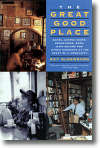 Remember 1200 baud Modems
Remember 1200 baud Modems Latte from A Matter of Taste Cafe
Latte from A Matter of Taste Cafe
The Office Goes Home
Over a short span of years, I’ve witnessed work migrate from a highly structured office setting, to home offices via telecommuting and now into the “Third Place”, a term coined by Ray Oldenberg in his 1989 book The Great Good Place.
Back in the early 1980’s, I was a pioneer of telecommuting, between Waterloo and Chicago via a state of the art 1200 baud modem, pictured above, no less. There was intense interest in this at the time, because as an extremely early adopter (too early some might say) of the telecommuting paradigm, I felt a bit like a guinea pig. In retrospect this workstyle enabled extreme concentration and productivity. At the same time, the primitiveness of the communications technologies, from network speed to the software then available, necessitated a lot of travel for in-person meetings. And, tellingly, the home office can ultimately be a lonely workplace, leading to a decrease in social interaction and overall motivation.
In that early revolution over the last 25 years, telecommuting saw work slowly migrate, or more typically intermingle, between the second place (the office) and the first place (your home). Telecommuting has changed traffic patterns, social life and, on the whole, provided an improved work experience by increasing knowledge worker flexibility.
Enter the “Third Place”
As an early adopter, not to mention beta tester, of many cutting edge mobile technologies and as a long time road warrior working on a number of geographically dispersed projects, I’ve often explored a work style that the Economist has labelled “mobile nomadism”, in their richly insightful 12 April 2008 special section on “The New Nomadism”. Always a great read, the particular Economist feature stands out, especially for those interested in mobility for social, technological, political, artistic or economics reasons. Last week, Alec Saunders ran a great SquawkBox conference call on iotum, with the podcast available on his blog here.
 The Great Good Place by Ray Oldenburg
The Great Good Place by Ray Oldenburg
In The Great Good Place, Ray Oldenburg characterizes the Third Place as:
“the place which is neither home nor work, where you spend comfortable time in easy association with friends and a few strangers.”
He celebrates the magic of the English Coffeehouse tradition and the seductive and widespread Viennese Cafe Culture as social gathering places that have often been scenes of political intrigue and even major business enterprise. Likely few are aware that in 1698, Jonathan’s Coffee-house in London started trading stocks and commodities, and eventually evolved into today’s London Stock Exchange. Ironically, Oldenburg was lamenting the decline of such third places.
Today’s revolution of being always connected, spawned by wiresless technologies, has dramatically reversed that decline. Version one of “on-demand” spaces is, of course, the humble WiFi enabled cafe. Locally in the Waterloo area, many establishments, beyond the ubiquitous Starbucks, have innovated in this genre, including:
- A Matter of Taste which is an amazing fusion of art, coffee and WiFi hotspot,
- Exhibit Cafe another melange of art and local, organic food right in the Children’s Museum,
- Williams Coffee Pubs, a local chain with food and long hours, popular with students doing late night assignments, hackers and even those working on offering memoranda, and
- C’est Bon Cafe, with its international flair and sinfully good Chocolate Fiesta Fire, and Refuge for village cocooning are great examples in bucolic Elora.
Initially, these cafes served as venues for meetings that were more informal, more conducive to creativity, and powered by wonderful Latte macchiato creations (pictured above). Eventually, I started to do small amounts of work there to increase productivity in the dead time between offsite meetings, including planning and brainstorming, reading briefing documents and eventually emails and, truth be told, writing this blog post. The environment is pleasant, a vibrant mix of people from a wide array of social backgrounds. It is worth noting that I always have the choice how much I wish to tune in or tune out those around me, just as I choose to go there to relax, work or both.
All new technology breakthroughs require adjustment. In this case, the major downside of nomadism is that the mix of real and virtual channels can lead to socially awkward situations. One is the issue of alienation, where people are more attuned to those they are in their virtual universe than those in the real world around them. While I may return to this topic at a later time, I would expect that society will eventually evolve a hybrid, multi-tasking communications style, learning to strike a reasonable balance between isolation and the global reach afforded by such virtual, always-on communications.
Instead I will focus on the opportunities. Beyond the obvious environmental benefits of reduced commuting, I strongly believe that the next generation of third places could serve to enrich our life as we build communities of the future. In Waterloo Region, there are signs that many are thinking about this challenge and building better third places that encompass peoples’ needs from business to the arts to entertainment and fun. In short, the building of vibrant, social spaces will create healthy cities of the future.
One aspect that is immediately apparent in the best of these first generation, third places listed above is the role of the arts in their mix. The simple coffee house is just the beginning. The impact of the arts is much more than art on the walls — it is a certain style and ambience you feel when you enter. Arts is an enormously creative endeavour, and I firmly believe, has a great affinity for the natural creativity inherent in the most innovative, knowledge-based companies of the 21st century. People like Alf Bogusky, Director General of KW Art Gallery have been developing a vision to reshape our urban spaces on a collaborative model based around the notion of third place. Historically, the arts institutions like art galleries, public libraries, theatres and concerts halls have been enclaves, walled off from the rest of the city. Alf and a group of leading thinkers have been mapping out a very different future, which exploits the natural synergies between all these stakeholders. Stay tuned …
In summary, we’ve witnessed a huge transaction through several generations of societal change from fixed offices to telecommuting and now rampant nomadism which is creating new spaces called the third place. I challenge all those who are beta testing the new mobile nomadism and who interact in these new third places, to please comment and share your experiences – we truly are building the city of the future in the context of the global village.
19 Apr 2008
0 Comments“The Third Place”: A Better Place?
The Office Goes Home
Over a short span of years, I’ve witnessed work migrate from a highly structured office setting, to home offices via telecommuting and now into the “Third Place”, a term coined by Ray Oldenberg in his 1989 book The Great Good Place.
Back in the early 1980’s, I was a pioneer of telecommuting, between Waterloo and Chicago via a state of the art 1200 baud modem, pictured above, no less. There was intense interest in this at the time, because as an extremely early adopter (too early some might say) of the telecommuting paradigm, I felt a bit like a guinea pig. In retrospect this workstyle enabled extreme concentration and productivity. At the same time, the primitiveness of the communications technologies, from network speed to the software then available, necessitated a lot of travel for in-person meetings. And, tellingly, the home office can ultimately be a lonely workplace, leading to a decrease in social interaction and overall motivation.
In that early revolution over the last 25 years, telecommuting saw work slowly migrate, or more typically intermingle, between the second place (the office) and the first place (your home). Telecommuting has changed traffic patterns, social life and, on the whole, provided an improved work experience by increasing knowledge worker flexibility.
Enter the “Third Place”
As an early adopter, not to mention beta tester, of many cutting edge mobile technologies and as a long time road warrior working on a number of geographically dispersed projects, I’ve often explored a work style that the Economist has labelled “mobile nomadism”, in their richly insightful 12 April 2008 special section on “The New Nomadism”. Always a great read, the particular Economist feature stands out, especially for those interested in mobility for social, technological, political, artistic or economics reasons. Last week, Alec Saunders ran a great SquawkBox conference call on iotum, with the podcast available on his blog here.
In The Great Good Place, Ray Oldenburg characterizes the Third Place as:
He celebrates the magic of the English Coffeehouse tradition and the seductive and widespread Viennese Cafe Culture as social gathering places that have often been scenes of political intrigue and even major business enterprise. Likely few are aware that in 1698, Jonathan’s Coffee-house in London started trading stocks and commodities, and eventually evolved into today’s London Stock Exchange. Ironically, Oldenburg was lamenting the decline of such third places.
Today’s revolution of being always connected, spawned by wiresless technologies, has dramatically reversed that decline. Version one of “on-demand” spaces is, of course, the humble WiFi enabled cafe. Locally in the Waterloo area, many establishments, beyond the ubiquitous Starbucks, have innovated in this genre, including:
Initially, these cafes served as venues for meetings that were more informal, more conducive to creativity, and powered by wonderful Latte macchiato creations (pictured above). Eventually, I started to do small amounts of work there to increase productivity in the dead time between offsite meetings, including planning and brainstorming, reading briefing documents and eventually emails and, truth be told, writing this blog post. The environment is pleasant, a vibrant mix of people from a wide array of social backgrounds. It is worth noting that I always have the choice how much I wish to tune in or tune out those around me, just as I choose to go there to relax, work or both.
All new technology breakthroughs require adjustment. In this case, the major downside of nomadism is that the mix of real and virtual channels can lead to socially awkward situations. One is the issue of alienation, where people are more attuned to those they are in their virtual universe than those in the real world around them. While I may return to this topic at a later time, I would expect that society will eventually evolve a hybrid, multi-tasking communications style, learning to strike a reasonable balance between isolation and the global reach afforded by such virtual, always-on communications.
Instead I will focus on the opportunities. Beyond the obvious environmental benefits of reduced commuting, I strongly believe that the next generation of third places could serve to enrich our life as we build communities of the future. In Waterloo Region, there are signs that many are thinking about this challenge and building better third places that encompass peoples’ needs from business to the arts to entertainment and fun. In short, the building of vibrant, social spaces will create healthy cities of the future.
One aspect that is immediately apparent in the best of these first generation, third places listed above is the role of the arts in their mix. The simple coffee house is just the beginning. The impact of the arts is much more than art on the walls — it is a certain style and ambience you feel when you enter. Arts is an enormously creative endeavour, and I firmly believe, has a great affinity for the natural creativity inherent in the most innovative, knowledge-based companies of the 21st century. People like Alf Bogusky, Director General of KW Art Gallery have been developing a vision to reshape our urban spaces on a collaborative model based around the notion of third place. Historically, the arts institutions like art galleries, public libraries, theatres and concerts halls have been enclaves, walled off from the rest of the city. Alf and a group of leading thinkers have been mapping out a very different future, which exploits the natural synergies between all these stakeholders. Stay tuned …
In summary, we’ve witnessed a huge transaction through several generations of societal change from fixed offices to telecommuting and now rampant nomadism which is creating new spaces called the third place. I challenge all those who are beta testing the new mobile nomadism and who interact in these new third places, to please comment and share your experiences – we truly are building the city of the future in the context of the global village.